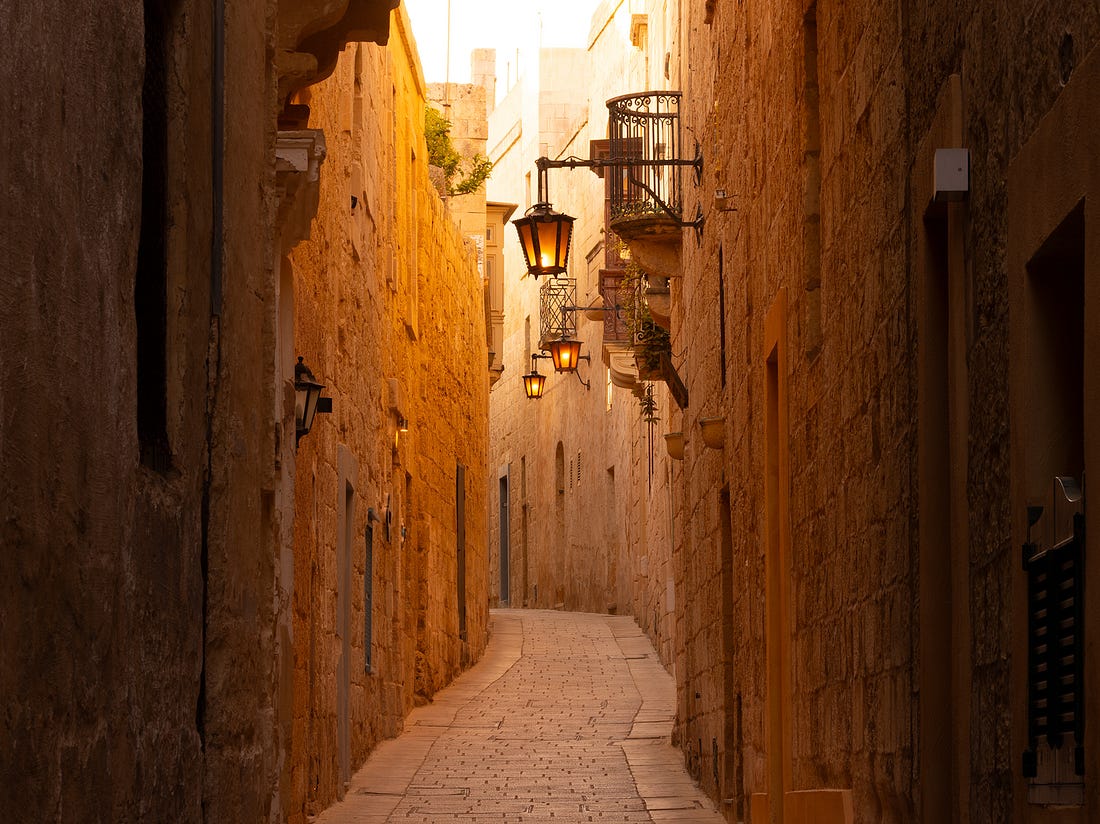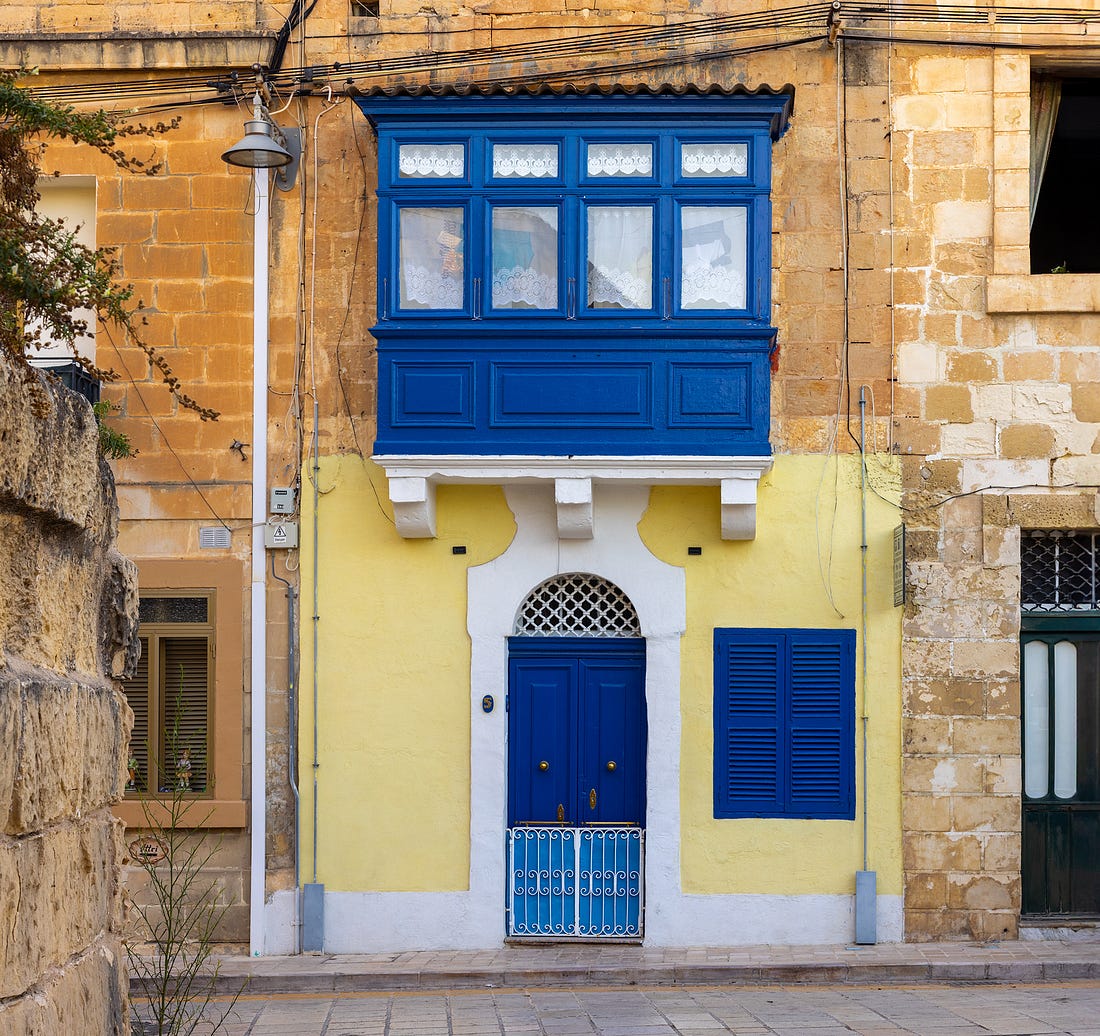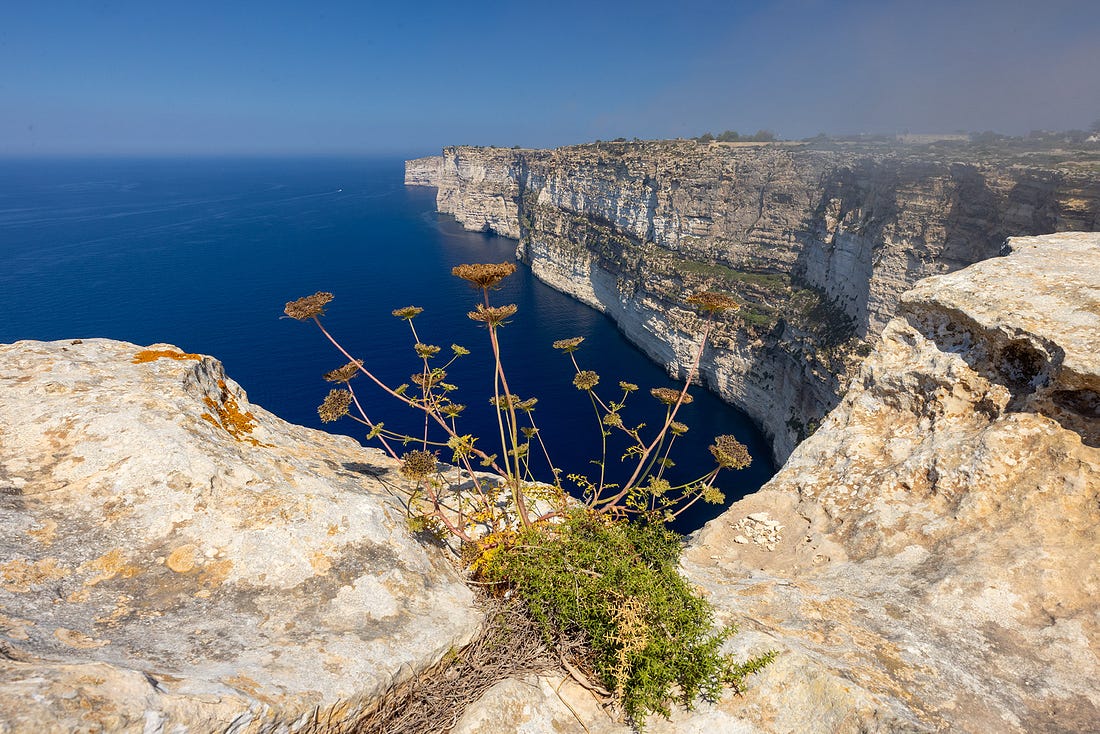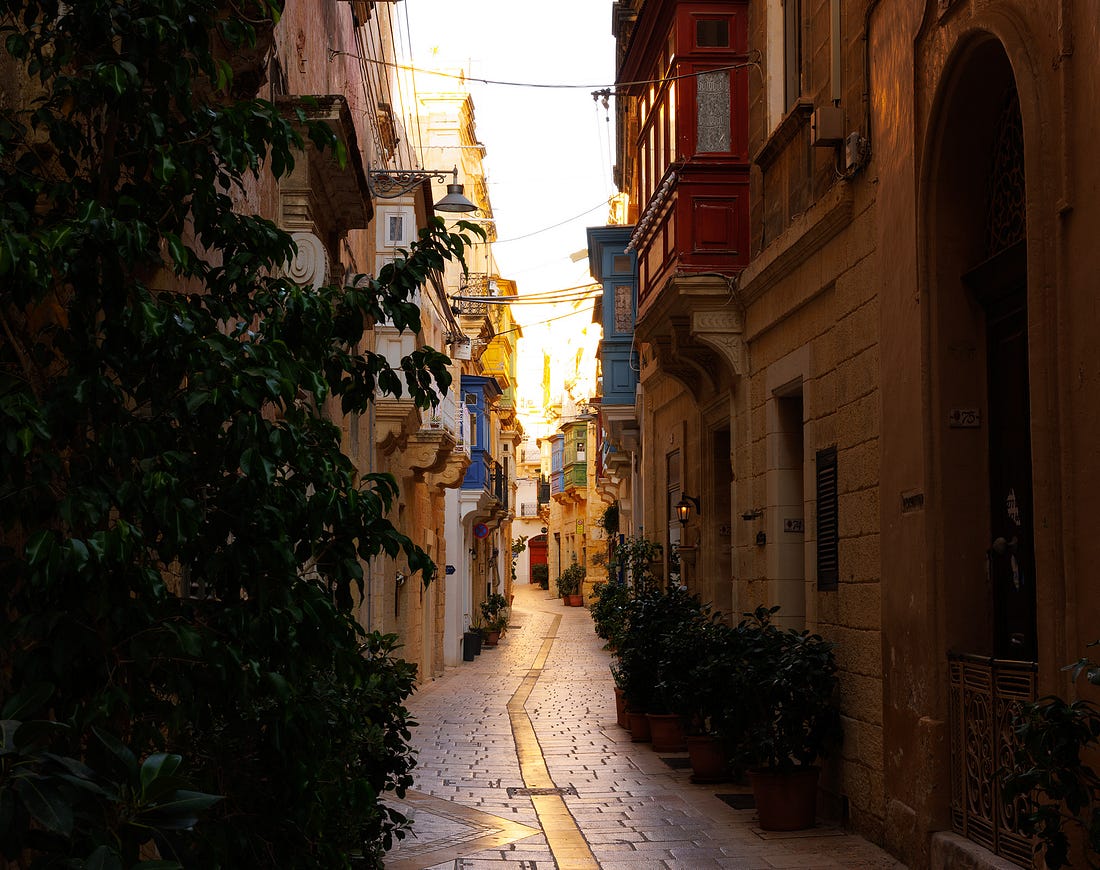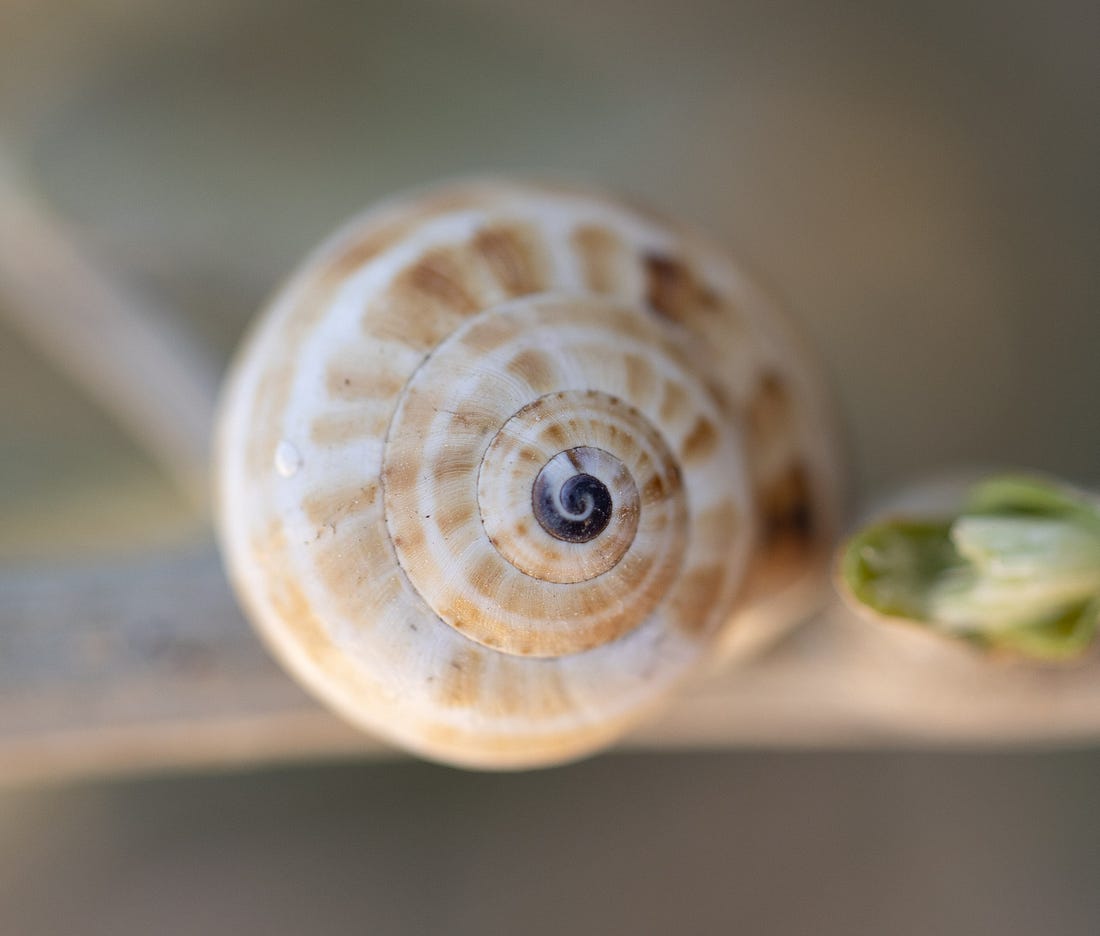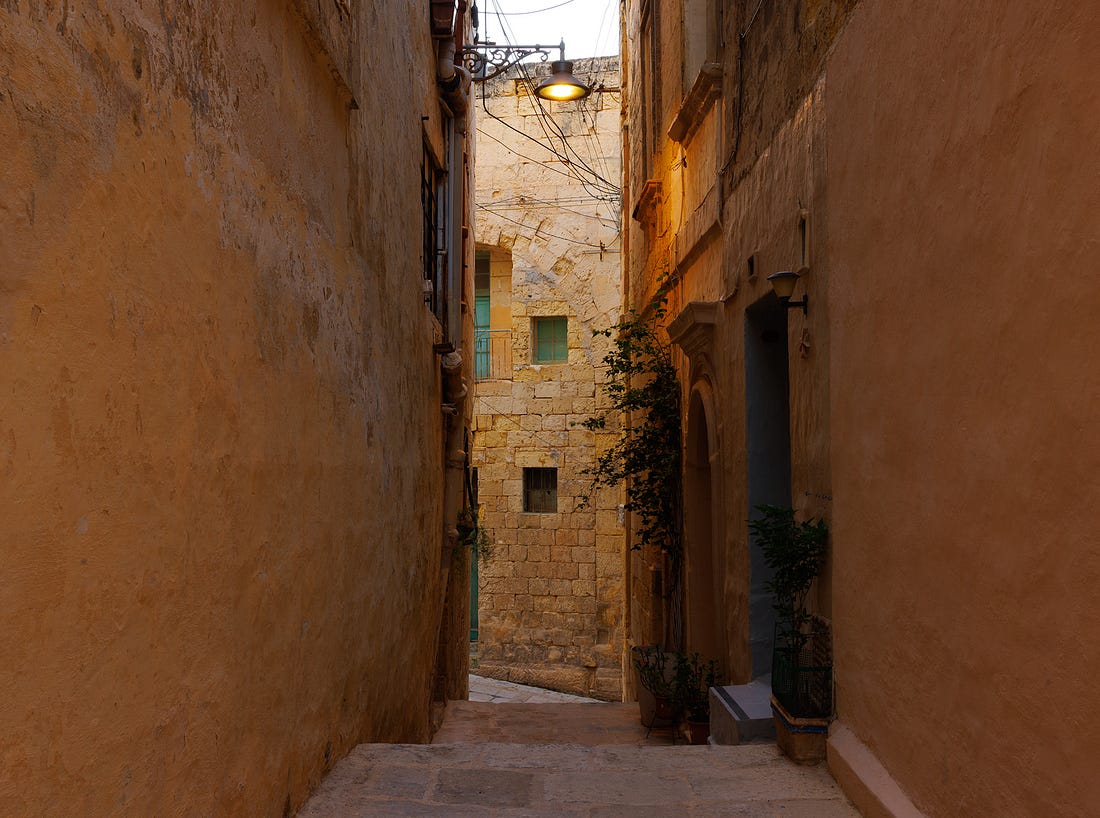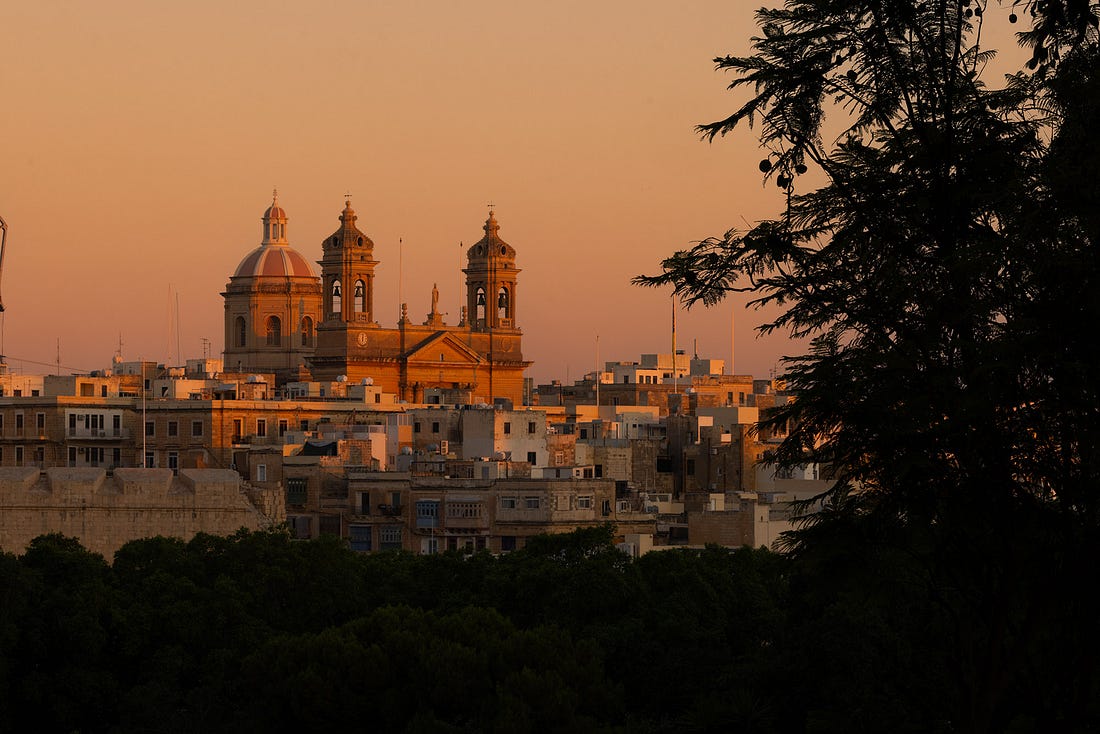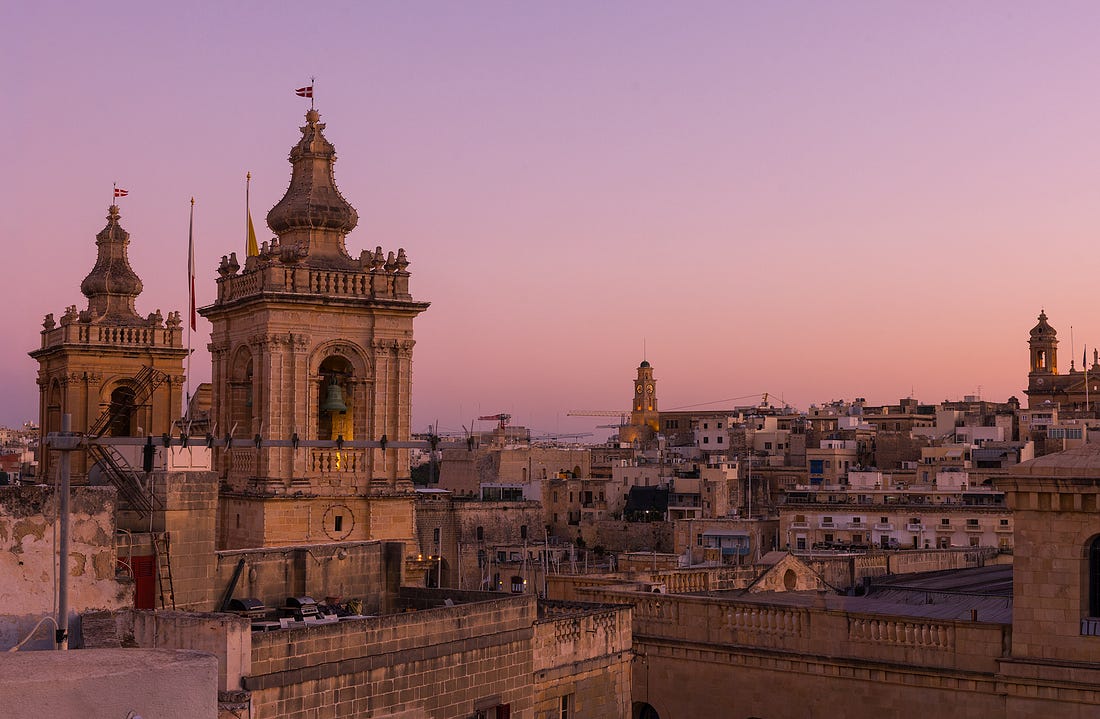The Ġbejna Journals in Gozo (Part III)In M'dina and the fields of Gozo, ġbejna cheese ends its 8,000-year journey through Maltese history.This long read can be read with high-resolution images here. It is the sequal to The Ġbejna Journals in Malta. M’dinaYou can see the walled hilltop city of M’dina from many parts of the island of Malta. “I still am mesmerized by it every time I see it,” Krzysztof, my rideshare driver says. “And I see it every day.” In the pre-dawn light, the city’s honey-colored Maltese limestone makes it glow like an ember. It is a fantasy set in an exotic land. It is also the key to understanding the origins of Malta’s most famous cheese, ġbejna. “It didn’t always look like that,” Krzysztof says. “The way it is now, it is from the Arabic times. That is why the name. M’dina, that comes from their name for it, ‘Medina.’” Krzysztof, who grew up in Poland’s Warsaw suburbs, is weighing how long he will stay in Malta. He’s working two jobs, saving money, hungry for the next move. Sicily next? Southern Spain? “How is it that you guys always know more about Malta than the Maltese?” I joke. He laughs, but doesn’t answer. Instead, he takes it as a welcome to keep going and points to the city surrounding M’dina. “That is Rabat. That is also Arabic name. But before the Arabs, this place was called Melite. It was Phoenician. Roman. Byzantine. There was a wall around the city then too, but it was a bigger city, it was the center of Malta.” He drops me off at the bridge which crosses to the M’dina Gate, a place that is so iconic it feels like I need a ticket to pass through. But in fact, I am the only one here, and once I enter the walled city, I have the streets to myself. Today, M’dina is a jewel box citadel, about 200 people live inside its walls. M’dina’s nickname is The Silent City: partly because so few people live here now, and partly because of how the Arabs rebuilt it after they conquered Malta. By 870 CE, Malta had become a neglected backwater of the Byzantine Empire, administered by nearby Sicily. Few people lived in the rural parts of the islands, and Malta was the fortified outpost of Melite. The Aghlabids of Tunisia initially besieged and conquered Melite, destroying much of the larger city, sending the Byzantine residents scattering into the country. But the Aghlabids, ruling from distant Kairouan, found Malta too poor and peripheral. They left. Their successors were Arabs and Berbers who came between shifting dynasties, and saw Malta as more than a conquest. Rather, a garden, a stronghold, and a stepping stone for trade with the Western Mediterranean. These later Muslim rulers transformed Melite into what would become M’dina. The Arabic M’dina was deliberately contracted, its footprint cut in half, its walls thickened. The empty outer quarters were left to crumble under the sun. The new M’dina was Arabic in every way. Straight Roman streets were rebuilt into winding alleys that turned at sharp angles. This approach had several advantages: winding alleys that confused invaders, cooled the air and created private spaces. As I walk deeper into the city, I feel all three of those elements. M’dina’s thick limestone walls do keep out the heat, and I feel like I am in a labyrinth where every nook is its own space; each alley resolves into a quiet courtyard. In the new M’dina, wells and irrigation channels carried water to groves of citrus and almond. Language changed too, as Sicilian Arabic took root in daily speech, a tongue that would outlive its rulers and turn into modern Maltese. M’dina instantly reminds me of a Minecraft world I made with my son when he was younger, one we worked on for years. It was a desert biome, and together we slowly built a narrow alley city of sandstone, a single block at a time. My son and I still have that world saved, and sometimes we talk about it—the most elaborate thing we ever built. But that Minecraft city had a precedent. Long before, we had wooden block worlds. We built elaborate castles with working railroad tracks that ran through arches and minaret towers. My ambition was always to see the trains run smoothly through the kingdom; my son’s instinct, at five years old, was to topple it all by running through it. If the imaginary cheese traveler, St. Deuberex Montclair, were with me right now, he would ask if I could fill my own imagination with M’dina after the Aghlabids left and the Arabs took over. So, I walk, and make myself see carved Kufic inscriptions above doorways, arched passages underneath horseshoe gates, and latticework windows where patterns of shadow and light scatter across stone floors. I imagine courtyards opening behind heavy wood and iron doors, where orange trees cool fountains tiled with mint blue mosaics. Although the narrow alleys would have been nearly as quiet as they are now, the actual population was likely about 3,000, or fifteen times its current population. As I find a central square, I can imagine this dense population. Here might have been a sprawling souq, endless stalls beneath canvas awnings filled with spices, olives, and bread fragrant with sesame. I imagine I am hearing so many languages. Mostly, it’s a North African Arabic dialect from Tunisia, but I also hear fragments of Greek and Berber and southern Italian dialects. I even hear Latin. Eventually, all these languages would fuse together to create the Maltese language. Under all its Italian and English vocabulary, that language’s core structure, grammar, and many everyday words would descend from the Arabic of this era. Now, Montclair would egg me on to visualize it. The most important thing and the reason I am here is that in one shaded corner, a cheesemonger would be displaying small white pucks curing on woven reeds. They are fresh, briny, and faintly herbal cheeselets, the size of racquetballs. On the shaded counter of the cheesemonger’s stall, these little cheeselets wait in neat rows. Still damp from the morning’s curdling. At first they look rustic, almost crude, but they are anything but simple. Their very existence depends on a suite of technologies and ideas bound in science that the Arabs brought to Malta. The milk of this cheese itself was richer because Arab and Berber herders bred and managed their sheep and goat flocks with an eye for hardiness and yield, drawing on centuries of animal husbandry refined across North Africa and Sicily. The pastures they grazed were sustained by advanced irrigation works. They had wells sunk into the limestone, underground qanats that carried water long distances, cisterns that gathered the scant rain, channels that parceled that water with geometric precision to orchards, fodder plots, and herb gardens. In these cheeselets themselves, you can see the science that the Arabs brought to Malta and its cheesemaking. Arab cheesemakers understood the principle of enzymatic coagulation: that rennet from the stomach of a young lamb or kid could separate curds from whey. They experimented with acids like lemon juice and vinegar to coagulate their cheese, and fig sap as an alternative to animal-based rennets. They dried their cheeses in stages, knowing how long sun and wind could preserve them without robbing them of character. Even the baskets and mats they used were engineered. These little cheeselets were designed so they could be stacked, traded, and carried. All of these new cheesemaking techniques were the result of applied science at the edge of a vast empire. We call this age (8th–13th centuries CE; but in Malta, 8th–10th centuries) the Arab Golden Age, an era when knowledge was cultivated, shared, and expanded through most of the known world. A cheesemaker in M’dina might never have read the great agricultural treatises of Baghdad and beyond, but the knowledge in those manuscripts flowed here through practice and tradition. One book, the Kitāb al-Filāḥa, is considered one of the great preserved documents of agriculture during this golden age. I read that it described crop rotation, irrigation, dairying, grafting, and preservation. For weeks, I tried to find an English translation, but none exist. I eventually learned how to translate the entire 433 page document, reading the way the author constantly focused on the scientific background of his document. “I have not set down a single rule in this book without testing it many times in practice,” he writes. And this beautiful passage, “Agriculture is one of the foundations of life, providing not only food for families but also a path to happiness and divine favor.” Physicians wrote about digestion. Astronomers, mathematicians, and chemists made leaps that transformed food and trade. The Arab world absorbed Indian mathematics, Greek philosophy, Persian astronomy, Spanish agronomy. The Arab world was the cultural jewel of the world during this time, and it’s because its membrane was permeable, fusing knowledge from every edge of their empire into a society bound by science, scholarship and education. Alongside these sciences, philosophy, literature, and the arts flourished, weaving foreign ideas, like those of Aristotle and Plato, into Islamic thought, while poets and travel writers captured the rich details of the age. At the heart of this culture were the madrassas, institutions where law, theology, and the sciences were studied side by side, embodying a society that saw education not as a privilege but as a civic duty. Madrassas were often free, sometimes open to girls as well as boys. So the cheeselets I am trying to visualize now were the distillation of an early Age of Enlightenment, and this basic cheese form still exists across the southern Mediterranean. The small, Maltese cheeselets we call ġbejna look similar to the fresh cheese found in North Africa today. This fact shows it, ġbejna is the direct descendant of these Arabic innovations, born in an age when knowledge, trade, and agriculture flowed across the Islamic world. Those Neolithic goat herders, and those Phoenician traders, and the Roman cheesemakers all left their mark on Malta’s dairy tradition, but it was in this period of Arab scholarship and agrarian enlightenment that ġbejna’s direct ancestor was born. GozoIt is early morning, and Jane and Kellan join me to catch a ride to the port. Our rideshare driver, Pawlu, grew up in northern Malta. When I see men tending empty fields, I ask him what grows in Malta. “Pretty much everything. But not in summer. Here in the north, it’s wheat and barley, figs, pomegranates, carob trees. Wine grapes. Lots of olives.” He struggles with some English words for produce, and I prod him on this. “No, no. We grew up speaking Maltese. Especially up here in the north. We use English in business, but not at home.” He grins when he says, “Only in Sliema,” referring to the modern, condo-heavy city near the island nation’s capital of Valletta. “We call them the ‘Tal-Pepes’,” their nickname for what they deem the rich Anglicized Maltese pricks of that area. He then speaks in a comedic English accent, repeating the little word that English speakers in Malta overuse. “I went to Hugo’s, pepe, to order a Spritz, pepe, and it was just fabulous.” Pawlu drops us off near the docks, and we board the ferry to Gozo, the smaller, greener and more rural of the two main Maltese islands, where most of the land is devoted to agriculture and shepherding. As we haul north along the Maltese coastline, and especially as we pass St. Paul’s Bay, we start to see them: heavy-boned limestone watchtowers sitting squat above the sea. They are cut from the same pale stone as the cliffs beneath them. Some have been cracked open by time, some are well restored. They all look like the rooks of an ancient unfinished chess game played by giants. And yet, they belong to a world built long after the embers of the Arab Golden Age had cooled. What happened? That age, the one that had brought irrigation to Malta’s terraces and scholarship to its markets, was beginning to dissolve from within. Across the Arab world, sermons grew louder than experiments. Observatories fell silent while astrologers spun myths. Physicians who had written encyclopedias now watched in shock as state-sponsored faith-healers and mystics promised cures in smoke and charms. The house of knowledge, once open to translations from Greeks, Persians, and Indians, began to shutter its doors to foreigners and immigrants. Fear crept in, replacing confidence; fear of heresy, fear of dissent, fear of the outsider. Foreign scholars who once found welcome in Cairo or Córdoba were now suspect, their words treated as poison. Borders that had been porous membranes of trade and learning devolved into barricades of suspicion. A society that had thrived by pulling in the wisdom of the world began to turn inward, clutching at purity. It was not a sudden collapse, but a long decay. The arteries of knowledge constricting, the gardens drying at the edges. Faith hardened into fundamentalism, and scholarship was eclipsed by ideology, as the empire’s reach shrank. For Malta, the irrigation systems remained, the alleys of M’dina were still a labyrinth, but the great engine of science and culture that had fed them was over. What had been a jewel in a wide-open world became a dim outpost, its rulers distracted. And so Malta, once cultivated as a garden citadel, became easy pickings for new people with new banners: the next wave in a shifting Mediterranean. Ta’ Ċenċ CliffsOnce on Gozo, we get a ride to the trailhead to the Ta’ Ċenċ plateau in the heavy heat of the morning. The path winds along pale limestone ledges where herbs release the scent of thyme, sage, and wild mint. Maltese Wall Lizards scatter under miles of wild fennel. At the edge of the white limestone cliffs, we can see the unbroken horizon of the blue Mediterranean. Above us, Pallid Swifts shriek and wheel. If Malta is a crowded, urban island, Gozo is quieter, greener, and more rural. It is the island of staples, much of which helps to feed the country. It is also the island of ġbejna. As Arab Malta crumbled, it became a fragment of empires, a small outpost whose rulers had grown distant. Into this gap came the Normans. These French-speaking descendants of Vikings, settlers of northern France, arrived in the islands in 1091. The Normans brought with them feudalism, the weight of Latin Christianity, and the northern European drive to order land and labor. In this new world, Gozo’s gentler valleys and fertile soils made it the breadbasket of the islands, feeding Malta’s towns and shipping produce northward to Sicily. Olive groves expanded, wheat terraces were extended, figs and carob were cultivated more deliberately. Monastic orders tied to the Norman court encouraged dairying, orchards, and preservation. Food on Malta was no longer about survival, but about provisioning a Christian stronghold at the southern edge of Christendom. It was on Gozo that ġbejna took on its final shape. If the Arabs had introduced advanced animal husbandry, irrigation, and the science of curdling, the Normans evolved and refined new methods of drying, storing, and trading. In this new era emerged the three classic forms of ġbejna: fresh ġbejna, soft and briny, tasting like mozzarella and eaten within days; sun-dried ġbejna, salted and cured by wind; and salt-cured and peppered ġbejna, hard enough to grate into soups and stews. Their French ancestry mattered. They came from lands where cheese was already a craft, as monasteries in Normandy were keeping records of cheesemaking, experimenting with curds and rinds, and treating cheese as both food and commodity. On Gozo, their habits reinforced the shepherd’s craft. Cheese in the Christian world was used more diversely, as it was tied to both feasting and fasting. After the Normans, new rulers came and went — Aragonese, Spaniards, Knights of St. John. Yet Malta’s essential foods endured where flags did not: olives, figs, wheat, and above all, ġbejna. St. Deuberex Montclair would have seen in Malta’s 8,000-year cheese history echoes of his own century. He knew the survival of institutions mattered more than the banners above them. “Follow the Arab world after the Golden Age,” he might warn, “how scholarship gave way to suspicion and retreat. I see the same in my lifetime, in the fascist tide of Germany and Italy, where science is censored and discarded.” As a cheese traveler in the 1930s, Montclair watched another Golden Age collapse. Inquiry in mathematics, physics, and philosophy was starved; scholars purged, books burned, questions replaced with ideology. And he would urge me to see the parallels in my own age. Today, across the United States, Brazil, South Korea, and the Philippines, powerful evangelical movements recast science as blasphemy. Not merely argued against it, but branded it as temptation, a danger to be feared. That suspicion has become fertile soil for authoritarians, men who promise certainty instead of discovery, obedience instead of understanding. The lamp of scholarship flickers once again, even as it is our most useful tool against our most existential threat: a rapidly warming world. History shows us that civilizations lose not only when they are conquered from the outside, but when they turn inward and declare war on their own scholars. The Arab Golden Age was built on curiosity and translation, but when conservative clerics gained the upper hand and painted philosophy, astronomy, and medicine as dangerous or even sinful, the tide turned. Science was no longer a tool of faith, but its rival. The culture that once cherished the pursuit of knowledge had recast it as blasphemy, and so the lamps of inquiry were extinguished. The parallels are not hard to see. In her book The Exvangelicals: Loving, Living, and Leaving the White Evangelical Church, journalist and former evangelical Sarah McCammon explains how today’s evangelical communities in the United States nurture the same suspicion of knowledge from the very beginning. She described how, as a child, she and other evangelical children were taught not to trust their teachers, to view science textbooks as lies, to see universities as corrupt dens of secularism. Parents and pastors frame biology, geology, and even history as hostile forces, part of a larger conspiracy against faith. By the time those children reach adulthood, their mistrust of science is complete. The soil has been prepared for authoritarian leaders who thrive on that suspicion. Just as clerics once extinguished the intellectual ferment of the Arab Golden Age, so too do modern fundamentalists seek to smother inquiry before it can take root. In Brazil, Jair Bolsonaro rose on a vast evangelical network that cast climate science and environmentalism as satanic conspiracies. He mocked vaccines, delayed COVID measures, gutted Amazon protections, and branded environmentalists enemies of the state. His government defunded universities as “Marxist” and attacked INPE, the space research agency, after it exposed record deforestation. As in Baghdad centuries earlier, when facts clashed with ideology, the scholars were punished. In the Philippines, Rodrigo Duterte cloaked his authoritarianism in religious legitimacy. Catholic and evangelical groups often blessed his violent populism as he dismissed climate science even while typhoons battered the country. Universities that criticized him were branded as communist fronts, and science became an enemy of the regime’s story. In South Korea, Yoon Suk Yeol rose with backing from conservative Protestant churches that long cast evolution, sex education, and women’s rights as threats. Fundamentalist sects fueled COVID outbreaks by denying epidemiology, and Yoon’s administration has echoed these currents under the banner of “traditional values.” In the United States, the evangelical bloc gave Donald Trump decisive backing. Science was recast as a moral adversary: climate programs were defunded, agencies like the EPA and NOAA weakened, and CDC scientists pressured to bend data to political rhetoric. In his return to power, Trump is cutting climate policy offices, hollowing out public health leadership, and pushing to gut the Department of Education—an effort to make science itself untrustworthy. The parallels are unmistakable. In each of these countries, fundamentalist voters legitimized leaders who treated knowledge as subversion and universities as adversaries. And Europe, too, is drifting inward, as nationalist parties from Hungary to Italy rally voters with the same suspicion of outsiders that once snuffed out the Arab world’s golden age. And Europe, the continent Malta looks toward, is not immune. Now nationalist movements, from Hungary and Poland to Italy and France, rally voters with the same fear of outsiders that undid the Arab world’s golden age. Immigrants are cast not as contributors to knowledge and economy, but as threats. In that suspicion, you can hear the same inward turn that snuffed out science in Baghdad and later fueled fascism in Europe. And here lies the stark parallel: just as the Arab world’s golden centers of learning collapsed when philosophy and medicine were branded as corrupting, modern democracies are now dimming their own lamps. History’s warning is that once science is recast as blasphemy, decline follows swiftly. Authoritarians have always known this. They cannot thrive in societies where knowledge is cherished, where scholarship is respected, where truth is tested and retested in the open. They need suspicion, fear, and faith without inquiry. And it is repeating now, in our time, as modern fundamentalists once again make knowledge into the enemy. BirguNow we’re back in our rented house in Birgu. Bags packed, fridge nearly bare: a bottle of water, a bowl of grapes, a sleeve of crackers, and a few racquetball-sized cheeselets. Jane spreads the sun-dried ġbejna, airy where feta is dense, faintly herbal, a little pecorino, onto the crackers. Simple, but it carries centuries in its rind. It strikes me that ġbejna is itself an immigrant. It was sketched in the Neolithic, sailed with Phoenicians and Romans, matured in the Arab Golden Age, was refined by Normans, shipped through Iberian markets, and provisioned for the Knights of Saint John. People came and went: Arabs, Berbers, Sicilians, French, Spanish, and the cheese adapted, endured, became Maltese. Today, ġbejna tan-nagħaġ, the sheep’s milk form, is Malta’s lone EU-protected food under Europe’s PDO stamp. The designation celebrates the long history of the cheese, but it also hints at its need for protection, its fragility. Protection is a legal fence. It cannot make the fields green. As seas warm and weather turns erratic, the same Mediterranean that once stitched empires together is heating up. Terraces thirst, aquifers shrink. The survival of a small island cheese, like the survival of these small islands, depends on whether our institutions can pass the climate test: science, democracy, cooperation, and cross-border governance. Kellan sits across from me, spreading cheese with the same offhand motion he used when he was small and delighted in toppling our wooden block cities. All the fantasy worlds of Malta bring back those memories. But I guess, now I realize that the way Kellan destroyed our wooden block worlds forced us to learn how to build again and again. It made us work together, a skill we carried into our Minecraft M’dina. In our old Minecraft world I tried to keep our version of M’dina pure, he kept adding railroad tracks through my alleys. That tug between preserving and rewiring feels like Malta itself: every age layering the new over the old, every generation rewriting. All those years of building turned us into a two-person institution. He is leaving for school soon. I love my family more than anything, but I recognize that my mark on the world is less genetic, but institutional: how we and our children contribute to the building up or the destruction of our institutions so that they thrive or decay in the next generations. Ġbejna exists because of institutions: scholarship and husbandry, laws and trade routes, markets and schools, monasteries and laboratories, writers and movements. Remove those and the cheese vanishes. Remove those and Malta vanishes. Remove those and we do. Outside, Birgu is quiet. Once the nerve center of Christendom under siege, now a quiet city of alleys jutting out into a grand harbor. Remember that the long passages of time when nothing seems to happen, between conquest and calamity, are where real history plays out, and what really determines what happens next: shepherds salting curds, fishers mending nets, families building worlds and knocking them down and building again. Kellan is no longer the boy who toppled my towers, but the young man who will go out and build his own. Notes from the Road is free today. But if you enjoyed this post, you can tell Notes from the Road that their writing is valuable by pledging a future subscription. You won't be charged unless they enable payments. |

